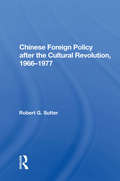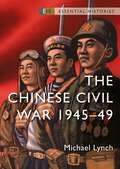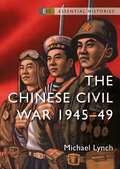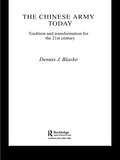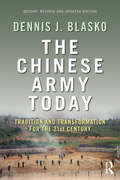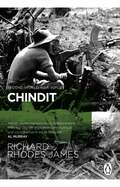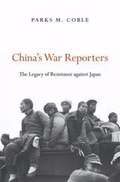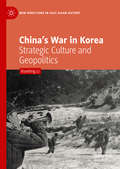- Table View
- List View
Chinese Grand Strategy and Maritime Power (Cass Series: Naval Policy and History)
by Thomas M. KaneThis challenging new book argues that the People's Republic of China is pursuing a long-term strategy to extend its national power by sea.
Chinese Grand Strategy and Maritime Power: Enduring Ideas From The Chinese Strategic Tradition (Cass Series: Naval Policy and History)
by Thomas M. KaneThis challenging new book argues that the People's Republic of China is pursuing a long-term strategy to extend its national power by sea.
Chinese Government Leaders in Manchukuo, 1931-1937: Intertwined National Ideals (Routledge Studies in the Modern History of Japan)
by Jianda YuanDrawing on historiography of the Japanese occupation in the Chinese, Japanese, and English languages, this book examines the politics of the Manchukuo puppet state from the angle of notable Chinese who cooperated with the Japanese military and headed its government institutions. The war in Asia between 1931 and 1945, and particularly the early years of the conflict from 1931 to 1937, is a topic of world history that is often glossed over or misinterpreted. Much of the research and public opinion on this period in China, Japan, and the West deem these Chinese figures to be traitors, particles of Japanese colonialism, and collaborators under occupation. In contrast, this book highlights the importance of analyzing the national ideas of Manchukuo’s Chinese government leaders as a method of understanding Manchukuo’s operating mechanisms, Sino-Japanese interactions, and China’s turbulent history in the early twentieth century. Chinese Government Leaders in Manchukuo, 1931-1937 fills a gap in this research and is an ideal resource for scholars studying wartime Asia and Europe, as well as non-specialist readers who are interested in collaboration in general.
Chinese Government Leaders in Manchukuo, 1931-1937: Intertwined National Ideals (Routledge Studies in the Modern History of Japan)
by Jianda YuanDrawing on historiography of the Japanese occupation in the Chinese, Japanese, and English languages, this book examines the politics of the Manchukuo puppet state from the angle of notable Chinese who cooperated with the Japanese military and headed its government institutions. The war in Asia between 1931 and 1945, and particularly the early years of the conflict from 1931 to 1937, is a topic of world history that is often glossed over or misinterpreted. Much of the research and public opinion on this period in China, Japan, and the West deem these Chinese figures to be traitors, particles of Japanese colonialism, and collaborators under occupation. In contrast, this book highlights the importance of analyzing the national ideas of Manchukuo’s Chinese government leaders as a method of understanding Manchukuo’s operating mechanisms, Sino-Japanese interactions, and China’s turbulent history in the early twentieth century. Chinese Government Leaders in Manchukuo, 1931-1937 fills a gap in this research and is an ideal resource for scholars studying wartime Asia and Europe, as well as non-specialist readers who are interested in collaboration in general.
Chinese Foreign Policy/h
by Robert G. SutterChinese foreign policy has changed radically since the Cultural Revolution of 1966-1969. This book focuses on turning points in China's policy and looks at the influence of foreign pressures on China. It assesses the impact of internal political struggles on the conduct of Chinese foreign affairs.
Chinese Foreign Policy/h
by Robert G. SutterChinese foreign policy has changed radically since the Cultural Revolution of 1966-1969. This book focuses on turning points in China's policy and looks at the influence of foreign pressures on China. It assesses the impact of internal political struggles on the conduct of Chinese foreign affairs.
The Chinese Civil War 1945–49 (Guide to...)
by Michael LynchOut of the ashes of Imperial China arose two new contenders to lead a reformed nation; the Chinese Nationalist Party, the Kuomintang, and the Chinese Communist Party. In 1927, the inevitable clash between these two political parties led to a bitter civil war that would last for 23 years, through World War II and into the Cold War period. The brutal struggle finally concluded when Communist forces captured Nanjing, capital of the Nationalist Republic of China, irrevocably altering the course of China's future. Dr Michael Lynch sheds light on this cruel civil war that ultimately led to the establishment of the People's Republic of China.
The Chinese Civil War: 1945–49 (Essential Histories)
by Michael LynchIn this fully illustrated introduction, Dr Michael Lynch provides a concise overview of the Chinese Civil War, a defining conflict in world history.Between the end of World War II and the dawn of the Cold War, one of the most important conflicts in modern history reached its climax. In this illustrated history, bestselling historian Dr Michael Lynch examines how the long struggle between Chiang Kai-shek's Nationalists and Mao Zedong's Communists exploded into an intense, brutal and ruthlessly fought civil war. Delving into the political background and complex ramifications of the conflict, he assesses Mao and Chiang's millions-strong armies, their strategies and commanders, and the critical campaigns that won and lost China. By 1949 the Nationalist government was defeated and in exile in Taiwan, and the new People's Republic of China was ready to emerge as a major Cold War power.Updated and revised for the new edition, with full-colour maps and new images throughout, this is a concise study of one of the bloodiest conflicts of the 20th century and its significant repercussions, the issues around which remain unresolved today.
The Chinese Civil War: 1945–49 (Essential Histories)
by Michael LynchIn this fully illustrated introduction, Dr Michael Lynch provides a concise overview of the Chinese Civil War, a defining conflict in world history.Between the end of World War II and the dawn of the Cold War, one of the most important conflicts in modern history reached its climax. In this illustrated history, bestselling historian Dr Michael Lynch examines how the long struggle between Chiang Kai-shek's Nationalists and Mao Zedong's Communists exploded into an intense, brutal and ruthlessly fought civil war. Delving into the political background and complex ramifications of the conflict, he assesses Mao and Chiang's millions-strong armies, their strategies and commanders, and the critical campaigns that won and lost China. By 1949 the Nationalist government was defeated and in exile in Taiwan, and the new People's Republic of China was ready to emerge as a major Cold War power.Updated and revised for the new edition, with full-colour maps and new images throughout, this is a concise study of one of the bloodiest conflicts of the 20th century and its significant repercussions, the issues around which remain unresolved today.
Chinese Battleship vs Japanese Cruiser: Yalu River 1894 (Duel #92)
by Benjamin LaiThe 1894–95 war between China and Japan, known in the West as the First Sino-Japanese War, lasted only nine months, but its impact resonates today. The Chinese Beiyang (Northern) Fleet was led by her flagship, Dingyuan, and her sister ship, Zhenyuan, which were the biggest in Asia; German-built armoured turret ships, they were armed with four 12in guns and two 6in guns, plus six smaller guns and three torpedo tubes. For their part the Japanese fleet, including the Matsushima and her sister ships Itsukushima and Hashidate, were each armed with a single 12.6in Canet gun and 11 or 12 4.7in guns, plus smaller guns and four torpedo tubes. The scene was set for a bloody confrontation that would stun the world and transform the relationship between China and Japan.Fully illustrated with stunning artwork, this is the engrossing story of the Yalu River campaign, where Chinese and Japanese ironclads fought for control of Korea.
Chinese Battleship vs Japanese Cruiser: Yalu River 1894 (Duel #92)
by Paul Wright Benjamin Lai Alan GillilandThe 1894–95 war between China and Japan, known in the West as the First Sino-Japanese War, lasted only nine months, but its impact resonates today. The Chinese Beiyang (Northern) Fleet was led by her flagship, Dingyuan, and her sister ship, Zhenyuan, which were the biggest in Asia; German-built armoured turret ships, they were armed with four 12in guns and two 6in guns, plus six smaller guns and three torpedo tubes. For their part the Japanese fleet, including the Matsushima and her sister ships Itsukushima and Hashidate, were each armed with a single 12.6in Canet gun and 11 or 12 4.7in guns, plus smaller guns and four torpedo tubes. The scene was set for a bloody confrontation that would stun the world and transform the relationship between China and Japan.Fully illustrated with stunning artwork, this is the engrossing story of the Yalu River campaign, where Chinese and Japanese ironclads fought for control of Korea.
The Chinese Army Today: Tradition and Transformation for the 21st Century
by Dennis J. BlaskoThe Chinese Army Today is a completely unique and comprehensive study of all elements of the Chinese military, focusing on its ground forces to a degree not found in any other contemporary works. In 1999, the military modernization program of the Chinese People’s Liberation Army that had been underway for twenty years increased in intensity and achieved a focus not seen in the previous two decades. Based primarily on actual Chinese sources, this book details the changes implemented since 1999 and puts them in the context of the many traditions that still remain. Written by a retired professional military officer who has served in China, this book presents the reader with the key developments since 1999. Its discussion on training and doctrine provides a level of detail not found in other works, but is essential to understanding the progress made in China’s military modernization and the obstacles yet to be overcome. The author uses first-hand observation of the Chinese military and three decades of military experience to weave many disparate threads from official Chinese statements, documents, and media reports into an integrated whole. This text defines exactly what forces make up the People’s Liberation Army and examines in detail ground force organization and structure, personnel policies, doctrine and training, new equipment entering the force, and missions routinely undertaken in support of society. This is an essential book for all students and scholars of China and Asia, political science and international relations and of contemporary military affairs and strategic studies.
The Chinese Army Today: Tradition and Transformation for the 21st Century
by Dennis J. BlaskoThe Chinese Army Today is a comprehensive study of the Chinese military, examining its ground forces in a level of detail not found in any other contemporary works. This new, revised edition has been fully updated to take account of recent changes in the institution. In 1999, the military modernization program of the Chinese People’s Liberation Army increased in intensity and achieved a focus not seen in the previous two decades. Based primarily on actual Chinese sources, this book details these changes and puts them in the context of the many traditions that still remain. Written by a retired professional military officer who has served in China, the text uses first-hand observation of the Chinese military and three decades of military experience to weave many disparate threads from official Chinese statements, documents, and media reports into an integrated whole. The author also conducts an in-depth exploration into the many forces that constitute the People’s Liberation Army. This is an essential book for all students of Chinese military and security affairs, and highly recommended for students of Chinese Politics, Asian Security, and International Relations and Strategic Studies, in general.
The Chinese Army Today: Tradition and Transformation for the 21st Century
by Dennis J. BlaskoThe Chinese Army Today is a comprehensive study of the Chinese military, examining its ground forces in a level of detail not found in any other contemporary works. This new, revised edition has been fully updated to take account of recent changes in the institution. In 1999, the military modernization program of the Chinese People’s Liberation Army increased in intensity and achieved a focus not seen in the previous two decades. Based primarily on actual Chinese sources, this book details these changes and puts them in the context of the many traditions that still remain. Written by a retired professional military officer who has served in China, the text uses first-hand observation of the Chinese military and three decades of military experience to weave many disparate threads from official Chinese statements, documents, and media reports into an integrated whole. The author also conducts an in-depth exploration into the many forces that constitute the People’s Liberation Army. This is an essential book for all students of Chinese military and security affairs, and highly recommended for students of Chinese Politics, Asian Security, and International Relations and Strategic Studies, in general.
The Chinese Army Today: Tradition and Transformation for the 21st Century (Asian Security Studies)
by Dennis J. BlaskoThe Chinese Army Today is a completely unique and comprehensive study of all elements of the Chinese military, focusing on its ground forces to a degree not found in any other contemporary works. In 1999, the military modernization program of the Chinese People’s Liberation Army that had been underway for twenty years increased in intensity and achieved a focus not seen in the previous two decades. Based primarily on actual Chinese sources, this book details the changes implemented since 1999 and puts them in the context of the many traditions that still remain. Written by a retired professional military officer who has served in China, this book presents the reader with the key developments since 1999. Its discussion on training and doctrine provides a level of detail not found in other works, but is essential to understanding the progress made in China’s military modernization and the obstacles yet to be overcome. The author uses first-hand observation of the Chinese military and three decades of military experience to weave many disparate threads from official Chinese statements, documents, and media reports into an integrated whole. This text defines exactly what forces make up the People’s Liberation Army and examines in detail ground force organization and structure, personnel policies, doctrine and training, new equipment entering the force, and missions routinely undertaken in support of society. This is an essential book for all students and scholars of China and Asia, political science and international relations and of contemporary military affairs and strategic studies.
Chindit vs Japanese Infantryman: 1943–44 (Combat)
by Peter Dennis Jon DiamondIn order to keep China in the war against the Japanese, the Western Allies believed they had to return to Northern Burma. Colonel Orde Wingate, a military maverick and proponent of guerrilla warfare, knew that a different type of British infantryman was required for this role – the Chindit, indoctrinated with special training – to re-enter the jungles and mountains of Northern Burma in order to combat the victorious Japanese forces there. The Chindits' opponents would include the 18th Division, one of Imperial Japan's most seasoned formations, which by 1941 had already accumulated as much operational experience as most Anglo-American divisions would acquire in the entire 1939–45 war. In a host of encounters the two sides clashed repeatedly in the harsh conditions of the Burmese jungle; the intended role and subsequent operational performance of the Chindits remains fraught with controversy today. Featuring full-colour artwork, specially drawn maps and archive photographs, this gripping study offers key insights into the tactics, leadership, combat performance and subsequent reputations of six representative Chindit and Japanese infantry units involved in three pivotal actions that hastened Japan's defeat in Burma during World War II.
Chindit vs Japanese Infantryman: 1943–44 (Combat)
by Peter Dennis Jon DiamondIn order to keep China in the war against the Japanese, the Western Allies believed they had to return to Northern Burma. Colonel Orde Wingate, a military maverick and proponent of guerrilla warfare, knew that a different type of British infantryman was required for this role – the Chindit, indoctrinated with special training – to re-enter the jungles and mountains of Northern Burma in order to combat the victorious Japanese forces there. The Chindits' opponents would include the 18th Division, one of Imperial Japan's most seasoned formations, which by 1941 had already accumulated as much operational experience as most Anglo-American divisions would acquire in the entire 1939–45 war. In a host of encounters the two sides clashed repeatedly in the harsh conditions of the Burmese jungle; the intended role and subsequent operational performance of the Chindits remains fraught with controversy today. Featuring full-colour artwork, specially drawn maps and archive photographs, this gripping study offers key insights into the tactics, leadership, combat performance and subsequent reputations of six representative Chindit and Japanese infantry units involved in three pivotal actions that hastened Japan's defeat in Burma during World War II.
Chindit
by Richard Rhodes JamesPart of the SECOND WORLD WAR VOICES series in partnership with the podcast We Have Ways of Making You Talk, presented by comedian Al Murray and bestselling historian James Holland.With a new introduction by Al Murray'Heroic, punishing excursions behind enemy lines, the Chindit expeditions are mythical and controversial in equal measure...Rhodes James takes us right to the heart of them' Al Murray__________________________________1943 - The fight to retake Burma is about to begin. Major-General Orde Wingate surprises the conquering Japanese Army with a daring raid they had no idea was coming. But this is just the beginning.Next, he devises a campaign of guerrilla operation to hit the invaders where it most hurts. Behind their own lines. Marshalling and training a lethal force of 10,000 men deep in the Burmese jungle, the Chindits are born.Cipher Officer Richard Rhodes James was part of that hidden army and chronicles the story of a band of brothers fighting for survival against a remorseless enemy and an unforgiving environment. Neither took any prisoners. The Chindits' daring actions and tactical brilliance laid the foundations for turning the tide of the war in the East.
China’s Wars: Rousing the Dragon 1894-1949
by Philip JowettChina is one of the great powers of the modern world. Yet in the late 19th century China was a ramshackle and isolated medieval empire upon whom the European colonial powers could impose their wishes at will. China's Wars describes the series of conflicts from 1894 to 1949 that forged modern China, from colonial clashes such as the Boxer Rebellion, through the chaotic years of warlord domination to the Japanese invasion, the Second World War and the bitter Civil War that followed. Previously unpublished photographs, contemporary pictures and specially-commissioned maps illustrate these tumultuous events and the men who fought them, events that would end with the eventual triumph of the Communist Party and the rise of modern China.
China’s Wars: Rousing the Dragon 1894-1949 (General Military Ser.)
by Philip JowettChina is one of the great powers of the modern world. Yet in the late 19th century China was a ramshackle and isolated medieval empire upon whom the European colonial powers could impose their wishes at will. China's Wars describes the series of conflicts from 1894 to 1949 that forged modern China, from colonial clashes such as the Boxer Rebellion, through the chaotic years of warlord domination to the Japanese invasion, the Second World War and the bitter Civil War that followed. Previously unpublished photographs, contemporary pictures and specially-commissioned maps illustrate these tumultuous events and the men who fought them, events that would end with the eventual triumph of the Communist Party and the rise of modern China.
China's War with Japan, 1937-1945: The Struggle for Survival
by Rana MitterIn Rana Mitter's tense, moving and hugely important book, the war between China and Japan - one of the most important struggles of the Second World War - at last gets the masterly history it deservesDifferent countries give different opening dates for the period of the Second World War, but perhaps the most compelling is 1937, when the 'Marco Polo Bridge Incident' plunged China and Japan into a conflict of extraordinary duration and ferocity - a war which would result in many millions of deaths and completely reshape East Asia in ways which we continue to confront today. With great vividness and narrative drive Rana Mitter's new book draws on a huge range of new sources to recreate this terrible conflict. He writes both about the major leaders (Chiang Kaishek, Mao Zedong and Wang Jingwei) and about the ordinary people swept up by terrible times. Mitter puts at the heart of our understanding of the Second World War that it was Japan's failure to defeat China which was the key dynamic for what happened in Asia.Reviews:'A remarkable story, told with humanity and intelligence; all historians of the second world war will be in Mitter's debt ... [he] explores this complex politics with remarkable clarity and economy ... No one could ask for a better guide than Mitter to how [the rise of modern China] began in the cauldron of the Chinese war' Richard Overy, Guardian'Rana Mitter's history of the Sino-Japanese War is not only a very important book, it also has a wonderful clarity of thought and prose which make it a pleasure to read' Antony Beevor'The best study of China's war with Japan written in any language ... comprehensive, thoroughly based on research, and totally non-partisan. Above all, the book presents a moving account of the Chinese people's incredible suffering ... A must read for anyone interested in the origins of China's contribution to the making of today's world' Akira IriyeAbout the author:Rana Mitter is Professor of the History and Politics of Modern China at the University of Oxford and a Fellow of St Cross College. He is the author of A Bitter Revolution: China's Struggle with the Modern World. He is a regular presenter of Night Waves on Radio 3.
China's War Reporters: The Legacy Of Resistance Against Japan
by Parks M. CobleWhen Japan invaded China in 1937, Chinese journalists greeted the news with euphoria, convinced their countrymen, led by Chiang Kai-shek, would triumph. Parks Coble shows that correspondents underplayed China’s defeats for fear of undercutting morale and then saw their writings disappear and themselves denounced after the Communists came to power.
China's War Reporters: The Legacy Of Resistance Against Japan
by Parks M. CobleWhen Japan invaded China in 1937, Chinese journalists greeted the news with euphoria, convinced their countrymen, led by Chiang Kai-shek, would triumph. Parks Coble shows that correspondents underplayed China’s defeats for fear of undercutting morale and then saw their writings disappear and themselves denounced after the Communists came to power.
China’s War in Korea: Strategic Culture and Geopolitics (New Directions in East Asian History)
by Xiaobing LiThis book re-visits the history of the Korean War of 1950-1953 from a Chinese perspective, examining Chinese strategy and exploring why China sent three million troops to Korea, in Mao’s words, to “defend the homeland and safeguard the country”—giving rise to what became the war’s common name in China. It also looks into the relatively neglected historical factors which have redefined China’s security concerns and strategic culture. Using newly available sources from China and the former Soviet Union, the book considers how interactive the parameters of defense changes were in a foreign war against Western powers, how flexible Chinese strategy was in the context of its intervention, and how expansive its strategic cultural repertoire was at the crucial moment to “defend the country.” Providing a re-examination of China’s military decisions and strategy evolution, this text narrates the story of successive generations of Chinese leaders and provides a key insight into security issues in China and Northeast Asia today.
China's Naval Power: An Offensive Realist Approach (Corbett Centre for Maritime Policy Studies Series)
by Yves-Heng LimThe rapid modernization of the Chinese Navy is a well-documented reality of the post-Cold War world. In two decades, the People's Liberation Army Navy has evolved from a backward force composed of obsolete platforms into a reasonably modern fleet whose growth is significantly shaking the naval balance in East Asia. The rationale behind China's contemporary rise at sea remains, however, difficult to grasp and few people have tried to see how the current structure of the international system has shaped Chinese choices. This book makes sense of Chinese priorities in its naval modernization in a 'robust' offensive realist framework. Drawing on Barry Posen's works on sources of military doctrine, it argues that the orientation of Beijing's choices concerning its naval forces can essentially be explained by China's position as a potential regional hegemon. Yves-Heng Lim highlights how a rising state develops naval power to fulfil its security objectives, a theoretical perspective that goes farther than the sole Chinese case.


